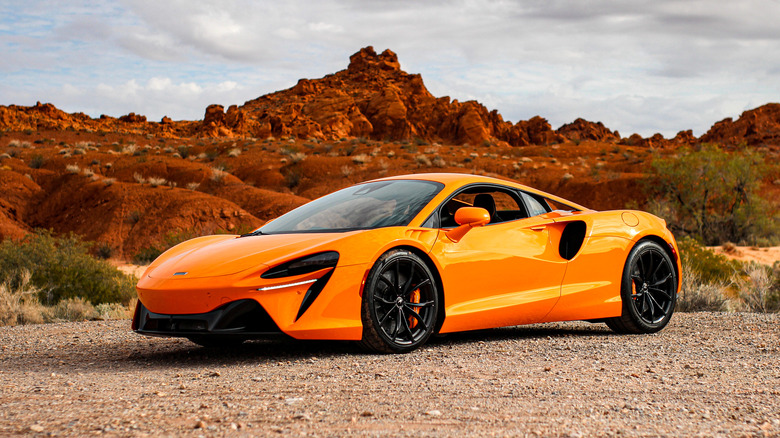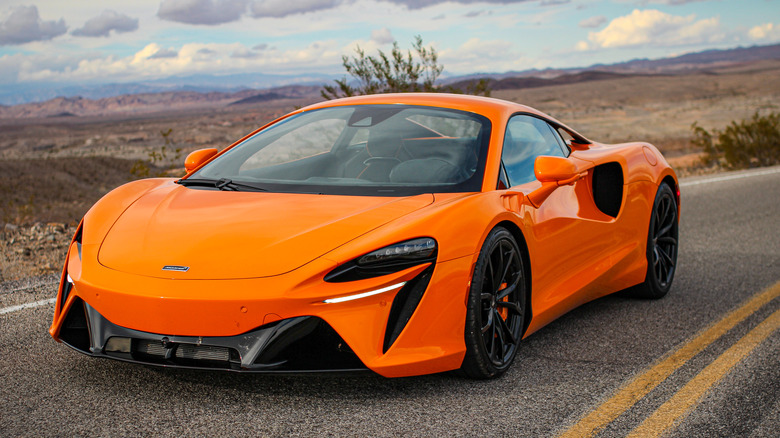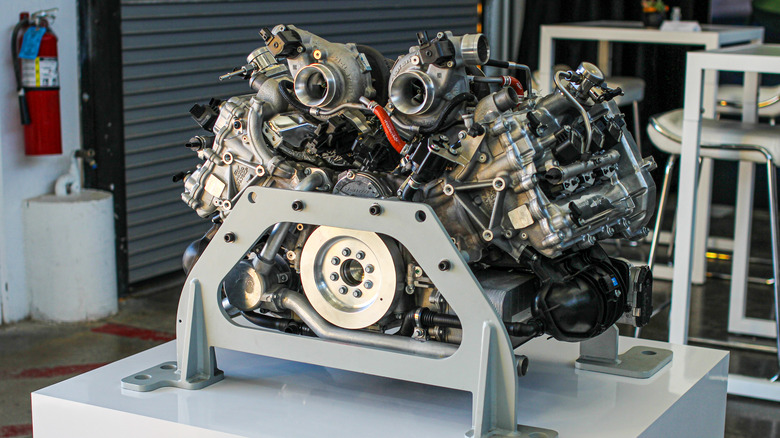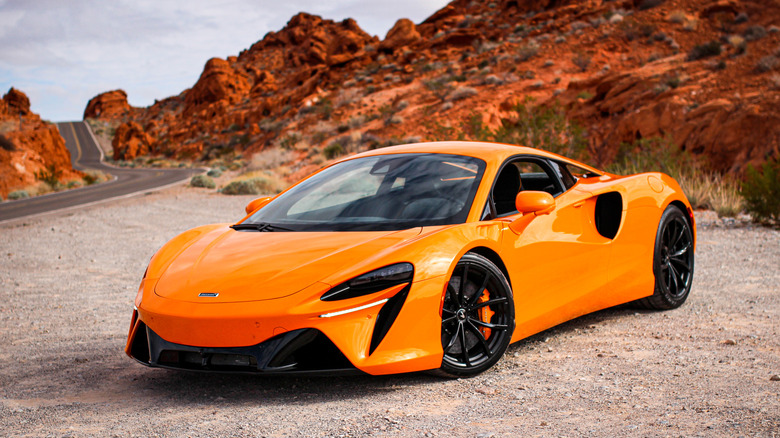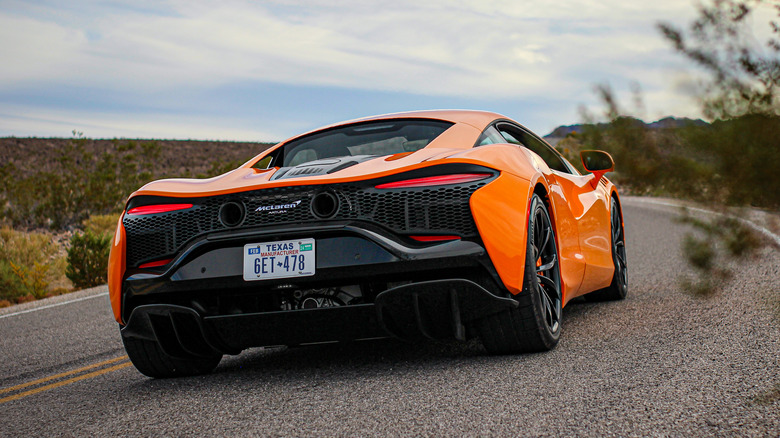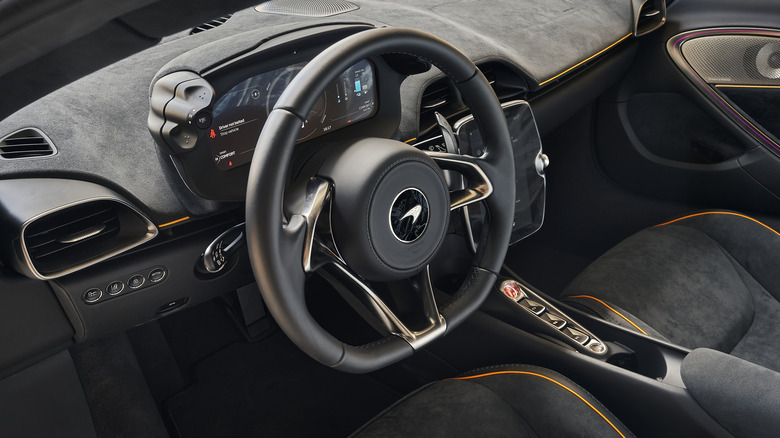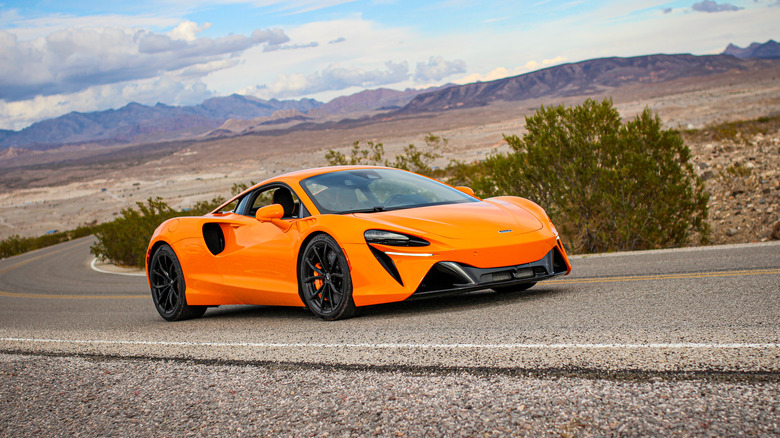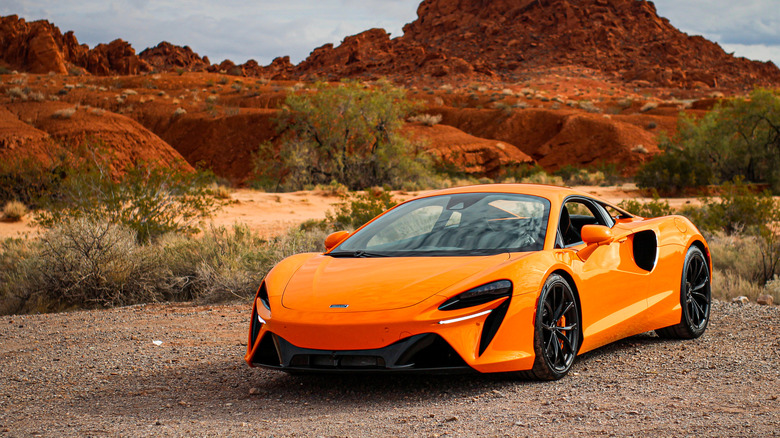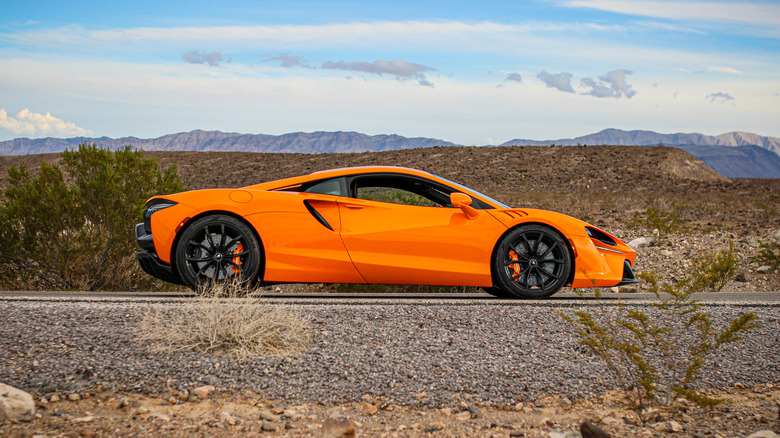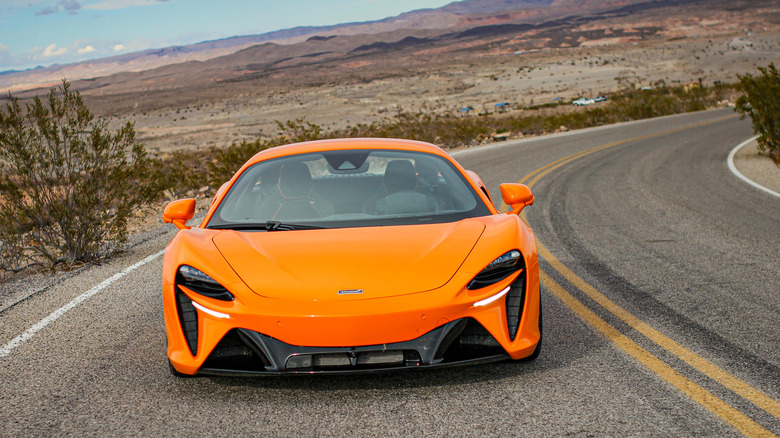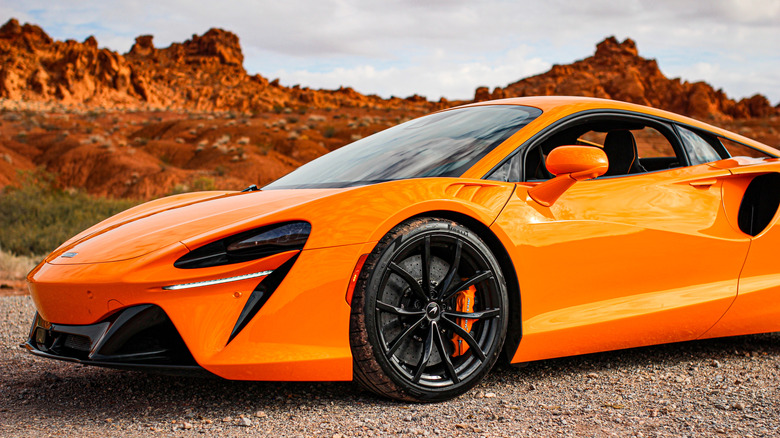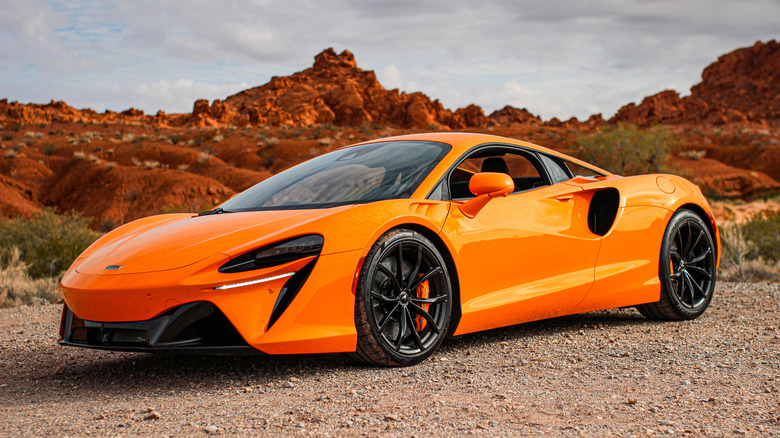Road Test: McLaren Hits The Jackpot With The 2023 Artura
McLaren was never meant to be a car company. Nearly 60 years ago, Bruce McLaren founded his eponymous racing team that would be a competitive and persistent presence in racing long after his passing and to this day. The brand would only start making cars in the late 80s, and that was just the ultra-limited McLaren F1. After a brief partnership with Mercedes-Benz, McLaren Automotive was founded 11 years ago, officially manufacturing sports cars for customers in earnest.
With this in mind, it's been an oft-repeated mantra that McLaren is a racing company first and an automaker second, with all the ups and downs that such a position entails. While its road cars have the benefit of fewer degrees between them and the race cars that inspire them, there have been growing pains involved with getting a young company sufficiently up to speed to compete with rivals in the same way it does on the track.
Its most recent entry-level vehicle, the McLaren GT, is the model for the company's awkward phase: rough around the edges, a mix of hand-me-down ergonomic flaws, and in-car tech that lags behind even the most basic offerings. It's a showcase of everything McLaren Automotive has been up until now, but that changes with Artura. Sleek, modern, and stunning, Artura is, frankly, McLaren finally achieving its full potential.
Double-down
The McLaren Artura is the sports car company's first full production hybrid. It picks up where the P1 hypercar left off and backs up the current limited-run Speedtail. Within McLaren's lineup, it sits with the 720S in the "supercar" category, between the aforementioned GT and the exclusive "ultimate" range.
Its centerpiece is the hybrid powertrain, comprised of a 3.0-liter twin-turbo V6 married to an e-motor, all of which is tied together by an 8-speed dual-clutch (well, technically triple-clutch, thanks to the e-motor) automatic transmission. The engine is a "hot vee" configuration, reducing the engine's overall size and positioning the turbos in a location for optimal efficiency. On its own, the power unit produces 577 horsepower and 431 pound-feet of torque, while the e-motor gins up an extra 94 horsepower and torque to lift the total combined output to 671 horsepower and 530 pound-feet of torque.
Most of the power is channelled by way of the 8-speed automatic, a one-gear increase from previous models for optimum power delivery and efficiency, though it evens out in a way since there's no reverse gear included in the Artura. The e-motor simply engages and runs in reverse to drive the car backward.
Let it ride
Much of the hesitation that comes around hybridizing a performance car comes mainly from our experiences with hybrid road cars, mostly configured primarily for efficiency. When these hybrid systems run out of juice, they're a hinderance. Thankfully, McLaren has approached the Artura in a way that reduces the compromise asked by such a powertrain. The electronics are there to support the powertrain and to be more self-sufficient in terms of recharge. Depending on mode, the V6 is constantly feeding power back into the battery, and while it can be plugged in and topped off in 2 or so hours at a Level 2 plug, it doesn't really require that most of the time. In that way, it's a far more synergistic unit where the e-motor complements the Artura's inherent performance rather than being a dominant component.
All of it sits in a brand new carbon fiber monocoque tub that's lighter and stronger than previous versions. It's supported by aluminum structures and a rear subframe and designed from scratch to support an electrified powertrain. Even the wiring harness has been reduced to shed weight. At the end of the day, the Artura weighs just over 3,300 lbs. Put it all together, and you've got a McLaren that can jump from 0 to 60 in 3 seconds flat and tops out at 205 mph, all while being capable of 39 MPGe by EPA estimates.
Clean cut
The Artura's exterior is a heat-molded aluminum shell made of as few panels as possible, which helps structurally and for the design. It has very distinct McLaren vibes, retaining a look that's very closely in line with the GT and the 570S that came before it. It's a sharp look, though I've rarely heard anyone complain about the outside of a McLaren. The interior, however...
In previous models, the company's inexperience as a customer-facing company was quite pronounced. McLaren is usually building its car around one specific person and if they weren't the driver then comfort and user friendliness wasn't on the checklist. This put them in a disadvantage in terms of interior ergonomics.
Sweet digs
The driving position was certainly good, but several little issues added up to big frustrations. Want to move the seat on a previous McLaren? Those buttons are deep in the same quarter-eating crevice beside the center console. Trying to use any of the digital gauge cluster menus? There's an extra, unintuitive stalk to use, which also doubles as the nose-lift. Don't even ask about using the navigation, media or HVAC, just suction cup your smartphone on top of it and be at peace.
Artura's interior, in contrast, is a massive relief in several ways. The quality of life updates make it a far more tolerable place to sit. More importantly, getting these elements right doesn't distract from the driving experience. Beyond a multitude of ergonomic updates, McLaren has used the Artura to streamline and improve the interfaces drivers will be using the most.
Most importantly, the controls for influencing the driving and handling settings have been moved from the center console to the binnacle housing the gauge cluster. No taking your eyes off the road for car controls: they're now literally at your fingertips. Many of the inputs for this screen have been simplified, too, making the stalk much more user-friendly. Nose lift even gets its own button.
Slot jockey
The largest improvement comes in the form of an updated infotainment system. The 8-inch touchscreen is much faster to respond to inputs and easier to use. A dedicated volume dial exists on the unit's edge and the device acts like a blown-up Apple Watch. It's a very welcome improvement, made better by the integration of Apple CarPlay (Android Auto is on the way). It's wired CarPlay, though McLaren states it can add wireless connectivity via an OTA update down the line.
Beyond the in-car tech, the McLaren has a number of driver assists implemented to make the Artura even easier to drive, such as 360-park assists, lane departure warning (off by default), and adaptive cruise control. The main takeaway from the interior is "feedback." McLaren took in customer comments and implemented massive changes. Its ergonomic updates in turn give the car the ability to provide increased driver feedback, all of which would come to fruition during the drive.
High stakes
I've had the tremendous privilege of spending a good amount of time with a few of McLaren's offerings, and what has stood out from them is their consistency. Macca's race-first approach gives the road cars a distinct feel of race parts bolted together with a thin sheet of civility draped on top. I mean this in the best way possible. McLarens have felt much more raw and exposed: there is heat, metal, air, and fluids in play to propel the car forward, and it's going to be loud. It's refreshing in light of how improvements in electronics and manufacturing can lead to most modern cars masking the mechanical magic on hand behind damping, design, and comfort-forward accoutrement. Don't ask how it works, just let it do its thing and have a good time.
Different McLaren models over time have smoothed out some of the rough edges, to varying degrees of success. The McLaren GT, for instance, is meant to be an approachable entry point into the McLaren lineup that's slightly more comfortable, manageable, and maybe less intimidating, but in actuality, it's more of what the automaker had already been doing for a while – sharing parts, being raucous and racy, and making the driver work for it. It's a blast, but it's hardly a step forward.
This is where the Artura differs. In a way, it's everything the GT should have been – updated, more crisp and with an up-to-date collection of technologies that we demand in the current age. And for extra giggles, let's throw in a boat load more power and efficiency while we're at it.
Lucky streak
For all the desperately needed updates, it would be a shame if some of that Macca magic was lost in the shuffle, but thankfully the automaker is aware of what makes its cars unique and have built around them. Steering remains hydraulically powered for maximum road feel and connectivity. In fact, any of the systems that could be fly-by-wire are purposefully avoided to maintain that high level of sensitivity. It means that things like steering and braking can't, say, change with the different drive modes, but they are consistently responsive through each setting. What has changed is how effortless every input has become, except the brakes which are as heavy as they should be for high-speed performance.
Fire up the Artura and the twin-turbo V6... does nothing. It defaults to e-mode on startup, which is a fun way to mess with your friends. It's also a handy way to sneak out of your neighborhood without announcing to everyone that you're taking a 671 hp supercar out for a thrash. McLarens past have divided the drive modes differently than the ones we're used to in other cars. Handling and Powertrain can be adjusted individually, with handling more or less determining the stiffness of the adaptive dampers, while drive mode influences the engine response, or lack thereof with the Artura's e-mode.
In this setting, the car can zip around town in relative silence for around 11 miles. Sure, there's a touch of fuel saving, but it's mainly to travel low-key in situations where a McLaren driver would like to try to not draw attention. With a car like this, it's a handy way of staying out of trouble, and the good thing is a heavy foot doesn't override it to kick the engine back. It's capable of getting up to highway speeds in this mode, but it's not intended to be most-used setting.
Chips are down
Comfort, Sport and Track are the three other power settings; each increase engine and transmission aggressiveness but they also up the level of battery recharge. Comfort gives back around 10%, but it's also the only mode that switches between motors depending on the speed. It will stay in electric mode until it hits 40 mph and will generally behave as a standard road-going hybrid. Sport and Track up the charge from 50 to 100 percent respectively, keeping the engine on at all times while the e-motor supports its acceleration.
It's really in the latter modes that the Artura's synergy is on full display. Throttle presses are smooth and instant, with the "hybrid" nature of it all obscured from the experience. This was a great relief to behold, as the nature of the joined powertrains does instill a modicum of concern when it comes to sports cars. In most cases, a hybrid powertrain leans heavily on the electrified side of things, and when that battery is depleted, it plummets from boon to hinderance, or until the next unlikely charge-up at least.
Here, it's the ideal partnership, with the V6 doing most of the lifting while the e-motor hypes it up, supports it, and highlights all of its key attributes. It isn't strictly necessary to plug it in and charge it all the time — the engine does that — and while there wasn't a chance to see how the Artura performed with a depleted battery, it doesn't ever really run dry. It always retains some level of charge, in case you were worried a dead battery meant no driving in reverse.
Straight flush
Find the right roads and the Artura manifests the supercar scenario of our dreams. The car's weight-saving and electrified input assists culminate into a car with a deft and light stride like a dancer. As the Artura skates down roads, its super-connected chassis is sending buckets of info up through the driver's arms, seat, and shoulders. Throw in the sports car's surprisingly excellent front and rear visibility and you get an unparalleled sense of connectivity.
Speaking of information, the Artura's displays are streamlined to the point where they're informative without being cluttered, and given that this is a hybrid, battery power and power flow data is ever present. Though this would usually be distracting, observing the state of charge becomes a passive element of the drive.
Let's say a typical journey starts off with a quiet e-mode roll out of town. The highway would then be a perfect place to switch to Sport or Comfort if there's traffic. Maybe you get lucky enough to discover some fun twisties worth exploring as you go. Along the way, the battery monitoring is light until you casually notice it might be low, or you're planning to use all of it later, so it's just a matter of running it in Track mode for a bit, which you probably want to do most of the time anyway. On that note...
Cash out
With all of its promises, the Artura is begging to be put on a track from the moment you sit inside. Beyond the usual questions of how it performs, there's also the issue of the hybrid system: though we've seen how synergistic it is on the road, will that stand up to the track? The answer is "yes, but..." on this one. While various street driving conditions allow for the battery charge to catch up, at full track clip, all of its power is being used in a full performance setting and thus diminishes much faster. Inevitably, it will drop down to that exhausted level where it will retain just enough charge for basic functions, and those extra 94 horses are gone.
Thankfully, it takes a while to get to that point. McLaren has estimated that it could tackle 40 miles at peak performance before there would be a degradation of performance. Depending on what track you call home, that's roughly 10 or so laps of full power.
The car's agility is noticeable in switchback situations, moving as fast as your hands can move and transferring the torque quickly to the side that needs it. If the back slips out, it's very easy to catch and correct without much of a second thought (though if there is, it's usually "hmm, I kind of want to slide that further when I come back around"). Given ample room to run, the Artura gets into the triple digits eagerly, and still has more to give, even though you'll inevitably have to engage the heavy brakes. At those speeds, their heft is appreciated: they take a solid amount of leg muscle to fully do the trick, and the richness of a hard stop is rewarding.
Betting the house
The McLaren Artura is McLaren stepping up its game in every category. We were already impressed with the driving experiences of vehicles-past, but this new car refines what's come before without shedding the characteristics that make McLaren distinct. All of the technological upgrades mercifully bring its conveniences into the modern age, doing them right so the focus can be properly on its performance, which is spectacular in its own right. The car's hybrid system does a great job of elevating the overall qualities of the powertrain in a synergistic manner, preventing it from being obtrusive or, indeed, a dominant aspect. Coming from a clean-sheet design, the underpinning structure of the Artura make it feel light and lithe with plenty of control, all in a very comfortable and usable ergonomic package.
Starting at $225,000, the McLaren Artura sits in a competitive class of impressive cars. It would be comparable to the Lamborghini Huracán EVO RWD or the less expensive Acura NSX, though both vehicles are not long for this world. As for new cars, the Maserati MC20 comes to mind and has been hinted at as a benchmark, particularly with its $217,000 asking price.
McLaren has put a ton on the line for the Artura, particularly a number of its heritage cars, so it's an important vehicle for the brand. From what we've seen, we're very eager to see what comes next if this is the start of a new age for the company, we just hope they get the chance to make it happen.
